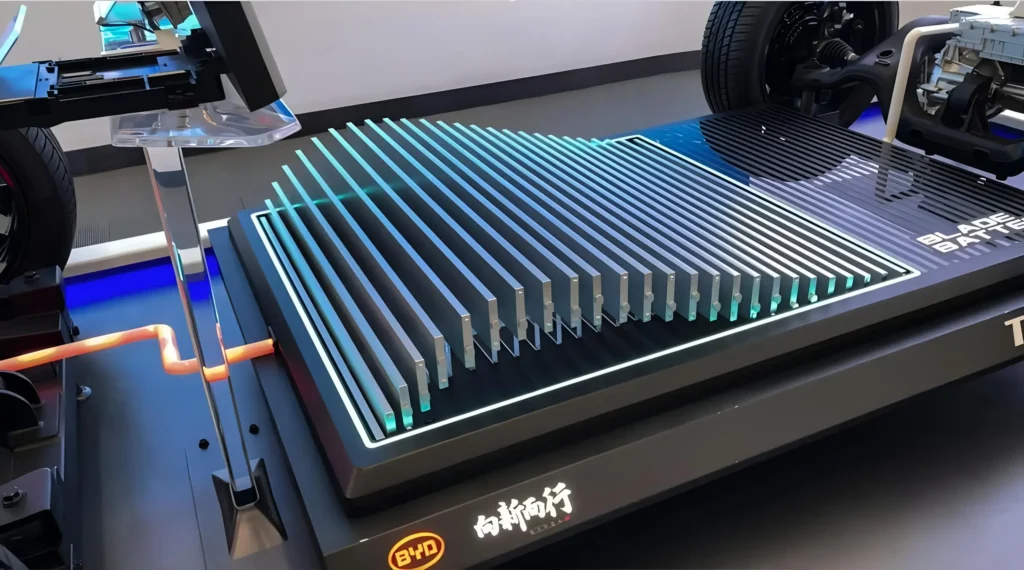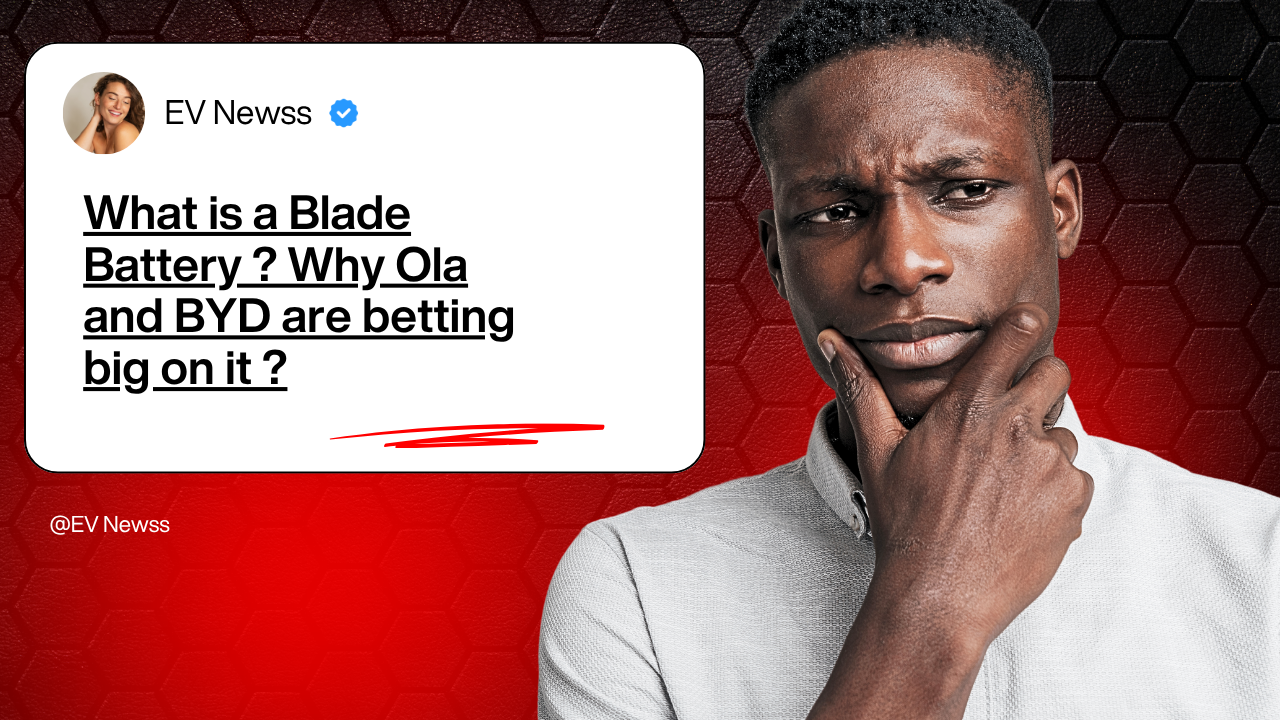India’s EV market is evolving rapidly in 2025, with automakers racing to adopt cutting-edge battery technologies. One innovation generating significant buzz is the Blade Battery, popularized by Chinese EV giant BYD and soon being integrated into Indian EVs, including those from Ola Electric.
But what exactly is a Blade Battery, and why are major players betting their future on it? Let’s dive into this revolutionary battery design and see why it’s considered the next big step for safer, more reliable electric mobility.
What is a Blade Battery?

A Blade Battery is a special type of lithium iron phosphate (LFP) battery developed by BYD (Build Your Dreams), a global EV and battery manufacturing leader. What makes it unique is its long, thin, blade-like structure, which offers several key advantages over conventional lithium-ion batteries:
- Higher safety due to improved thermal stability
- Better space utilization in the battery pack
- Longer life cycle, often exceeding 3,000 charge cycles
- Lower cost, especially when scaled for mass production
The Blade Battery is engineered to be extremely resistant to fire and impact, addressing one of the biggest concerns in electric mobility: battery fires and thermal runaway.
Blade Battery vs Conventional Lithium-ion Batteries
| Feature | Blade Battery | Conventional Lithium-ion |
|---|---|---|
| Cell Chemistry | LFP | NMC or LFP |
| Form Factor | Thin blades | Pouch or cylindrical |
| Safety | Very High (No fire in nail tests) | Medium to High |
| Energy Density | Moderate | Higher |
| Life Cycle | 3000+ cycles | 1000–1500 cycles |
| Cost | Lower (LFP base) | Higher (especially NMC) |
While Blade Batteries may not match NMC cells in energy density, their superior thermal management and safety make them ideal for Indian climates, where high temperatures pose a serious risk.
Why BYD Is Leading the Blade Battery Revolution
BYD unveiled the Blade Battery in 2020 and has since used it in multiple EVs like the BYD Atto 3, Seal, and Dolphin. The company has:
- Tested it rigorously, including nail penetration and crush tests
- Shown zero fire incidents even under extreme abuse
- Achieved international certifications for safety and reliability
BYD’s in-house battery production capability allows it to scale fast and control quality, giving it a global edge.
Ola Electric and the Blade Battery Influence
Ola Electric, India’s fastest-growing EV startup, has hinted at adopting similar LFP Blade-style batteries in its upcoming electric scooters and future four-wheelers. The company has:
- Set up a battery innovation center in Bengaluru
- Partnered with global battery experts
- Committed to LFP chemistries for enhanced safety
Though Ola doesn’t use the exact BYD Blade cells (due to proprietary tech), its battery packs are designed in a blade-like modular format to mimic those safety and performance benefits.
Advantages of Blade Batteries for India
- Fire Resistance: Proven to resist fire in extreme testing—key in India’s hot climate.
- Longevity: 3,000+ charge cycles equals over 10 years of typical usage.
- Cheaper Raw Materials: LFP doesn’t require nickel or cobalt, reducing costs.
- Compact Design: Higher space efficiency allows more room for passengers or cargo.
- Sustainable: Easier to recycle than NMC counterparts.
Applications Beyond Cars: Blade Batteries in Two-Wheelers & Buses
- Two-Wheelers: Brands like Ola are exploring compact Blade-based packs for scooters.
- Electric Buses: BYD’s e-buses in India already use Blade tech for added safety.
- Energy Storage Systems: Ideal for solar + battery setups due to long life and thermal stability.
Challenges and Limitations
Despite its benefits, Blade Battery tech has a few limitations:
- Lower energy density vs NMC means slightly reduced range
- Cold weather performance is weaker than NMC (less relevant for India)
- Larger cells require precision in BMS (Battery Management System) calibration
The Future of Blade Batteries in India
India’s focus on safety, affordability, and thermal management makes it a prime market for Blade Battery adoption. Expect to see:
- Wider use in sub-₹20 lakh EVs (cars and scooters)
- Local manufacturing of LFP blade cells in Gujarat and Tamil Nadu
- Integration in energy storage and battery-swap networks
FAQs – Blade Batteries and EVs in India
Q1. Is the Blade Battery available in India?
Yes, in models like BYD Atto 3 and some BYD electric buses.
Q2. Is it safer than normal EV batteries?
Absolutely. It has passed rigorous safety tests including nail and crush tests without catching fire.
Q3. Can Blade Batteries be used in electric scooters?
Yes, compact versions are being developed for two-wheelers and smaller EVs.
Q4. Who makes Blade Batteries?
BYD is the original developer, but other Indian and global firms are working on similar formats.
Q5. Is it better than solid-state batteries?
For now, yes in terms of cost and availability. Solid-state batteries are still in the R&D stage.
Conclusion: A Safer, Smarter Battery for Indian Roads
Blade Battery technology is poised to transform India’s EV market by solving two major concerns: safety and durability. With automakers like BYD and Ola pioneering its adoption, and with support from local manufacturing and government incentives, Blade Batteries could soon become the gold standard for Indian EVs in 2025 and beyond.
Whether you’re an EV enthusiast, startup founder, or prospective buyer, understanding Blade tech gives you a window into the future of safer and smarter mobility in India.

1 thought on “What is a Blade Battery? Why Ola and BYD are betting big on it?”